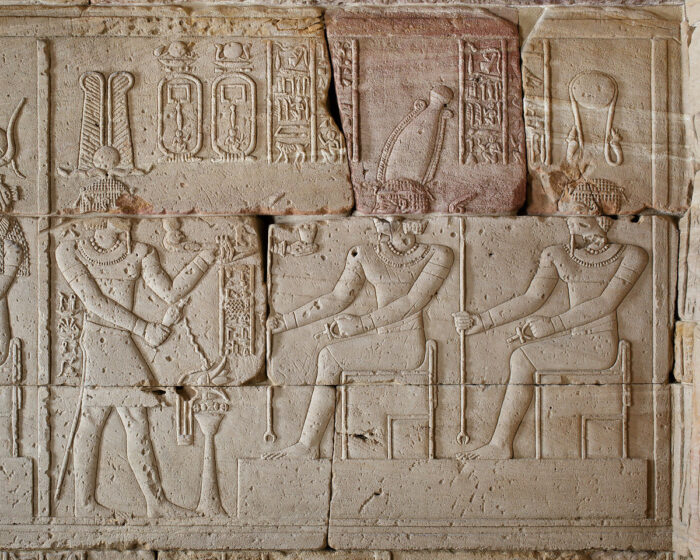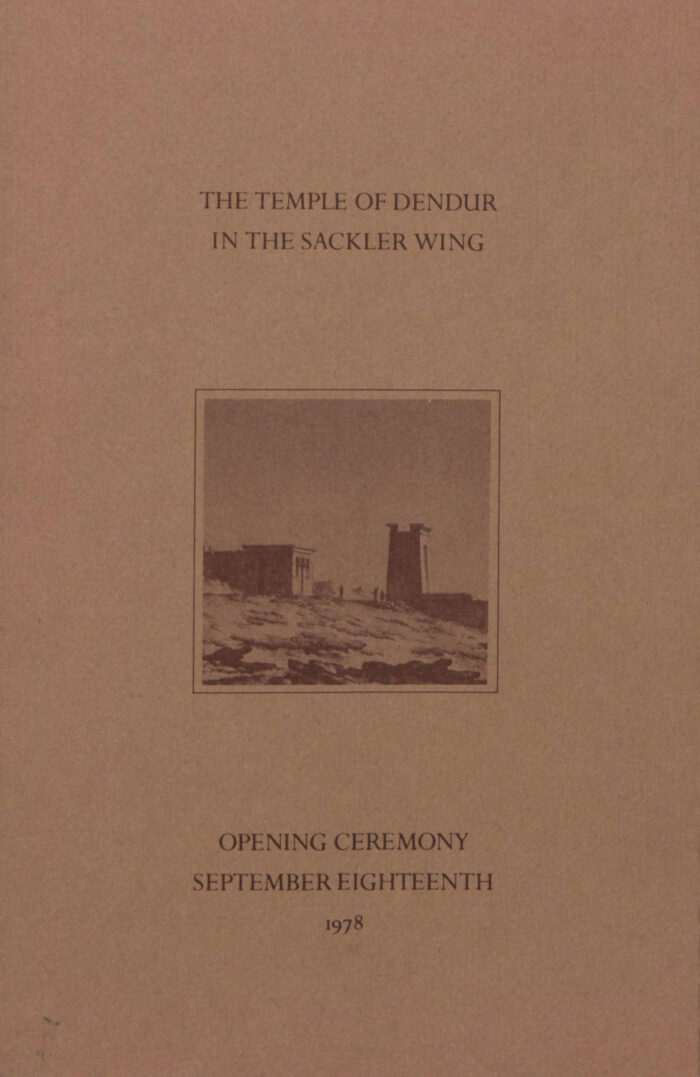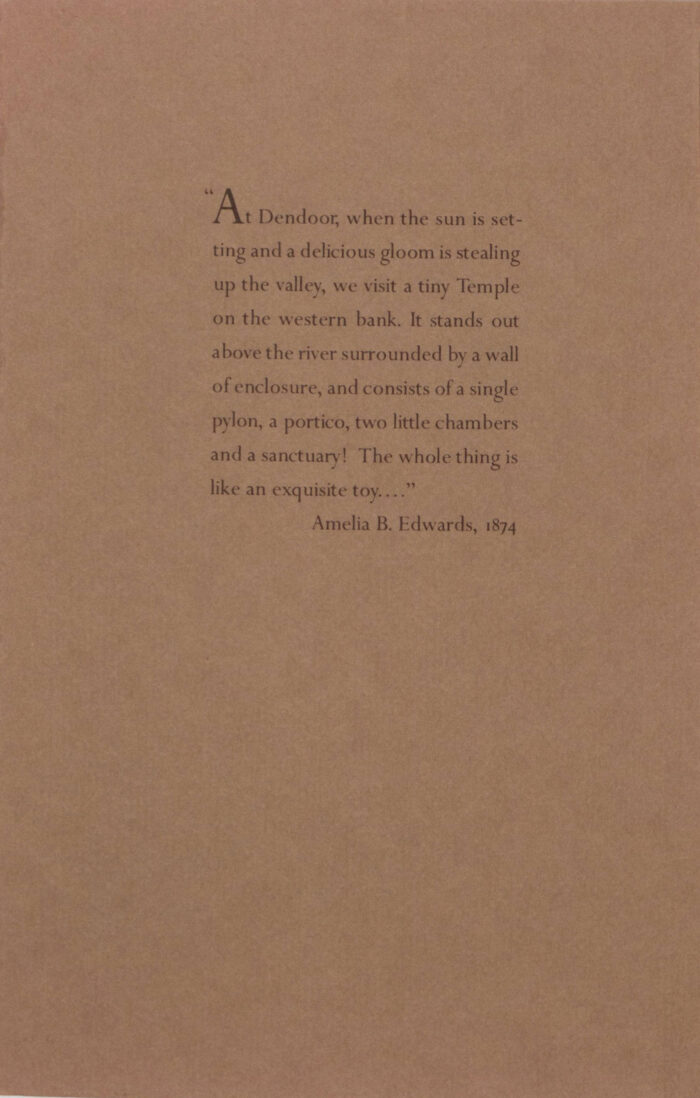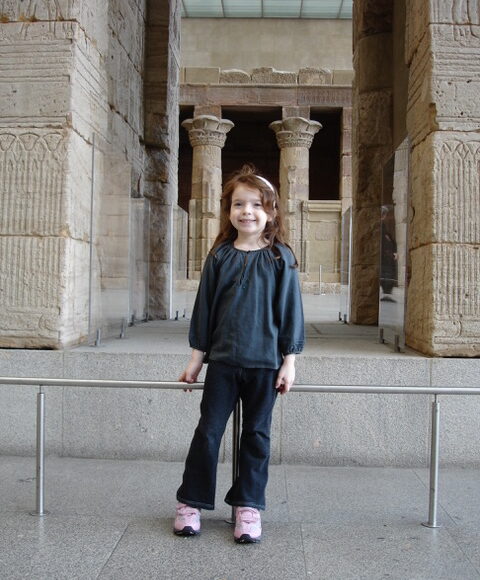

Sophie and The Temple
The Temple of Dendur was an object of my imagination. To a shorter-than-average kid, it seemed larger than life. In reality, the Temple is considered to be on the smaller side. Still, the Temple seemed tall. With two columns on the porch and a high entrance gate, the construction seems to reach up. Additionally, above the gate and the porch entrance to the Temple there are inscriptions of images of the Sky god Horus. This seems to hint at a tall, almost ancient skyscraping nature to the Temple. Inside the Temple carvings and reliefs depict Pedesi and Phihor, the deified children of a Nubian ruler as well as the King (remember this).
But the Temple of Dendur is more than just an amazing artifact; it represents a complex history of conquest, imperialism, and commercialization. The Temple of Dendur is not just Egyptian. It was actually built during the Ptolemaic period when Egypt was ruled by Emperor Augustus. Though the Temple was during this period in 20 and 10 BCE, it was built by locals and thus lived up to Egyptian architectural and cultural standards. Yes, the Temple was built in accordance with tradition, but the structure also commemorates the Roman conqueror of Egypt! However, Augustus is portrayed as a traditional pharaoh. He makes offers to Isis. This imagery is an act of resistance through art; the Egyptians are conceding Augustus’ victory but they are forcing him to be a pharaoh, which is a push for their own sovereignty in a sense

© The Metropolitan Museum of Art 2000-2021
How did the Temple of Dendur end up in America? At the Met?
Following the Egyptian Revolution of 1952, the nation set out to build a dam. The dam flooded Lake Nasser, and 22 monuments were at risk, including Dendur. For more about the Dam, click here. Since many important monuments were at risk, UNESCO stepped in. The U.S., Spain, Italy, and the Netherlands helped as well. As a “thank you” each country received a Temple; America received the Temple of Dendur. The idea that Egypt would “gift” such an important object seems highly irregular and laissez-faire compared to today’s standards for the trade of art and artifacts. Especially since Egypt was one of the first nations to enact cultural heritage laws in 1859. After museums across the nation competed, President Johnson awarded the Temple to the Met, making clear the new intention for the Temple. Dendur wasn’t awarded to a public museum, a museum in a city like Cairo or Memphis (named after Egypt), or to a museum with more traffic, instead it was given to the most prestigious museum to be displayed like a crown jewel. Still, even if we accept this gifting as an outdated but formerly acceptable practice, the Met treated the Temple in a way that could only be described as oddly disrespectful.
In the original brochure for the Temple, for one, there is no formal thank you to Egypt. The Temple is proclaimed as “ A gift to the people of the United States from the people of Egypt.” There is no actual gratuity, just an air of boastfulness. Also, the brochure does not explain its history or significance. Instead, it includes a quote from Amelia B. Edwards, which is problematic for a number of reasons (see description under the image of her quote). It seems as though the Met was (and is?) more concerned about what they can use the Temple of Dendur for rather than the actual building itself. So it’s another huge irony that Edwards describes the Temple as a Toy. Thinking back to the time I once went to a Pajama Party at the Temple (It was advertised in Time Out New York and had food, music, and activities) the Temple was quite literally functioning as a toy for children. Here is a link to a recent version of the event.

Program published on the occasion of the installation of the Temple of Dendur at the Metropolitan Museum of Art. Copyright © The Metropolitan Museum of Art
This was the opening page of the brochure. It shows the Temple in Egypt. Note that the Temple is in the Sackler Wing.

Program published on the occasion of the installation of the Temple of Dendur at the Metropolitan Museum of Art. Copyright © The Metropolitan Museum of Art
This page of the brochure includes a quote from the “Archaeologist” Amelia B. Edwards. The full quote is as follows, “At Dendoor, when the sun is setting and a delicious gloom is stealing up the valley, we visit a tiny temple on the western bank. It stands out above the river surrounded by a wall of enclosure, and consists of a single pylon, a portico, two little chambers and a sanctuary! The whole thing is like an exquisite toy, so covered with sculptures, so smooth, so new-looking, so admirably built. Seeing them half by sunset, half by dusk, it matters not that these delicately-wrought basreliefs are of the Decadence school. The rosy halflight of an Egyptian afterglow covers a multitude of sins, and steeps the whole in an atmosphere of romance.” Calling the Temple a “toy” and insinuating that it is romantic is highly offensive. Also, it doesn’t help that Edwards is infamous for using COFFEE to “clean” a statue of Ramses II in Abu Simbel.

Program published on the occasion of the installation of the Temple of Dendur at the Metropolitan Museum of Art. Copyright © The Metropolitan Museum of Art.
Here is the list of contributors which includes Esmet Abdul Meguid, the Ambassador from Egypt.
The Temple of Dendur in the Sackler Wing : opening ceremony, September eighteenth, 1978.
Program published on the occasion of the installation of the Temple of Dendur at the Metropolitan Museum of Art. Copyright © The Metropolitan Museum of Art
Lastly, here is the final description in the program, calling the Temple a “gift.”
Looking back at the pictures of me in front of the Temple I can’t help but wonder, am I as bad as Alice, was the Temple of Dendur a toy to me? But it’s more complex than that. Yes, I am complicit in colonization by going, but I am not a perpetrator; rather I have fallen victim to the Met’s new, commercial narrative for the Temple. Looking back to the pajama party, my parents saw the article, and because of successful marketing, they believed taking us would make us “cultured”- it wasn’t an active choice to undermine Egyptian ideals. You can have weddings and corporate events at the Temple of Dendur. The Met Gala is held there every year. Chanel even had an Egyptian themed fashion show at the Temple in 2018!! Ultimately, the Met has profited off the Temple by changing the narrative of Dendur being a suspiciously acquired cultural artifact to, well, a toy of the New York Arts and Culture scene.
Sophie Hyde is a first year student from New York City. She is planning on majoring in Art History with a minor in Museum Studies. I grew up in and around museums and art. I took my first art classes at the Met and my mom even claims I learned to walk under the whale at the Natural History Museum. Since then, I’ve had a love for the visual arts and the museums of New York City.
